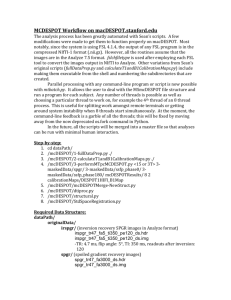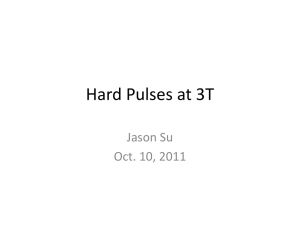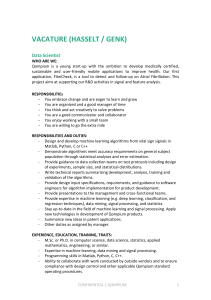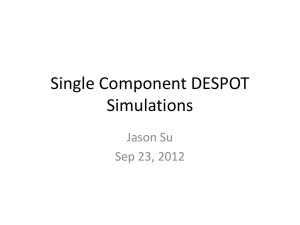_x0016_An open framework for parameter mapping and image
advertisement
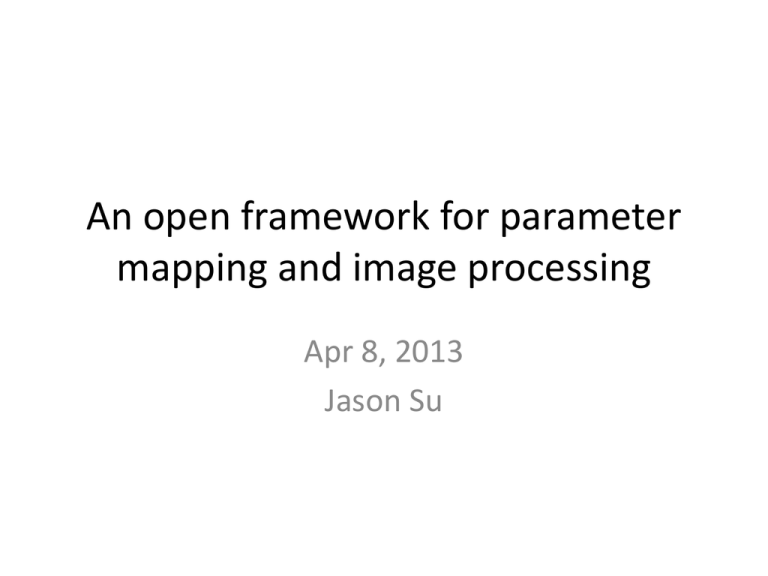
An open framework for parameter
mapping and image processing
Apr 8, 2013
Jason Su
Motivation
• Mapping methods share many common tasks and
features
– Fitting of a tissue model to data with a known signal
equation
– Multi-subject processing
– Residuals and statistics analysis to evaluate fit
– Pause and resume, recovery from crash
• We should promote code sharing in the community, so
groups around the world can experiment with
promising new mapping methods
Goals
• There are 2 audiences, coders and users
• For developers of novel methods:
– Provide a framework that fosters readability and code
re-use
– Easy to convert a bare-bones implementation into
production-level functionality, avoid code re-writes
– Provide easy ways to speed up code: embarrassing
parallelization (across slices or subjects) and caching
– What else do developers need?
• Data/error visualization
• ?
Goals
• For clinicians and users:
– A consistent workflow and usage pattern for
producing a multitude of mapping methods
– Support for all platforms
– Scalability to large-subject studies and diverse
computing resources
• Amazon EC2 has built-in support for Python
• A community
– Open source repository to share and improve
The Framework: Protocol class
• Like when we sit down at
the scanner, we start with
a protocol
• Input is readable JSON,
not an inscrutable stream
of command-line switches
• Instantiates a bunch of
Series and manages
access to their image data
– I’ve assumed voxel-wise
fits
{
"Mask": {
"filename": “brainMask_mask.nii.gz"
},
"SPGR": [
{
"filename”: "spgr_fa3000.nii.gz",
"flip_angle": 3.0,
"repetition_time": 6.74,
"weight": 2
},
...
{
"filename": "spgr_fa8000.nii.gz",
"flip_angle": 8.0,
"repetition_time": 6.74
}
],
"SSFP": [
{
"filename": "ssfp_fa11000_ph0.nii.gz",
"flip_angle": 11.0,
"repetition_time": 3.6,
"rf_phase_cycle": 0.0,
"weight": 2
},
...
]
Series class
• Defines important scan
parameters, can pull from
DICOM header
• Loads image from disk
• SPGR and SSFP are
implemented
– Flexible for any
combination of phase
cycles, TRs, flip angles
• B0, B1/Kappa, ROI?
Utilities module
• Memoization/caching of
expensive results
• pandas data structures
inspired by R
– Vectors and table data
frames with named access
• Notification of other
functions when data
changes
>> @memo
def stats(x):
return (mean(x), std(x))
>> x = DataFrame(d, index=['a', 'b', 'c', 'd'])
P001 P002
Types 'RRMS' 'SPMS'
EDSS 3.5 6.0
>> x['Bob']
>> y = notify_container_factory(
DataFrame)(stats,
data=x)
>> y.ix['EDSS'] = [4.0 7.0]
-> stats() function is called and recomputes
mean and std. of EDSS
Implementing a signal equation
• Define a TissueModel
– RelaxationTissueModel
• Take parameters from TissueModel and compute expensive
intermediate parts of the signal equation:
– SPGRSystemArray and SSFPSystemArray
• Finally, incorporate sequence parameters from a Series and
compute the intensity at a voxel
– SPGRSignal and SSFPSignal
• Series are able to discover the modules that model their signal
behavior
– Automatically looks for the module based on its name
– SPGRSeries is tied to the sequence.spgr module
TissueModel class
• A bare-bones base class that provides a flexible dictionary
hierarchy and notification
> model.parameters['myelin']['fraction'] = 0.2
• Methods:
–
–
–
–
add_notifiee
del_notifiee
desync – do something when the model is changed
sync – call notifiees, propagate the changes
• Notifiees are called in the order they are added, duplicates
are ignored
• Acts like a state machine
• Classes group/organize functions and the data they
manipulate under common umbrellas
RelaxationTissueModel
• Converts parameters to
pandas DataFrame for
vectorized operations
• N-component relaxation
model
– mcDESPOT is usually 2component
– Pure tissue, does not include
terms like RF phase cycle
• desync enforces model
assumptions
– Chemical equilibrium and unit
total volume
component_list = [
{
'name': 'intraextra',
'T1': 1000,
'T2': 70,
'off-resonance': 0.1,
'fraction': 0.75,
'exchange_rate': {'myelin': .1, 'csf': 0 }
},
{
'name': 'myelin',
'T1': 800.0,
'T2': 30.0,
'off-resonance': 0.2,
'fraction': 0.2,
'exchange_rate': {'intraextra': .1, 'csf': 0 }
},
{
'name': 'csf',
'T1': 5000.0,
'T2': 300.0,
'off-resonance': 0.3,
'fraction': 0.05,
'exchange_rate': {'intraextra': 0, 'myelin': 0 }
}
]
model = RelaxationTissueModel(component_list)
Simplifying Assumptions
• 2 component model
f S 1 f F
– Only need to find fF (the fast volume fraction)
• Chemical equilibrium
f F kFS f S kSF
– Allows us to eliminate finding k
SF=1/τS
• Both components are on the same resonance
F S
SPGR/SSFPSystemArray
• Subclassing promotes
code re-use
– SPGR is the simpler
form, so SPGR extends it
• Computes shared
intermediate quantities
• A shared cache
between different
objects
• Notified by TissueModel
1
k SF
RF F
T k FS
2,F
1
kFS
k SF
0
T2,S
1
0
k FS
RF F
T2,F
ASSFP
0
RF S
k FS
0
0
0
0
0
0
0
0
RF S
0
kSF
0
1
k SF
T2,S
0
0
0
1
kFS
T1,F
k FS
0
0
0
k SF
1
k FS
T1,F
0
SPGR/SSFPSignal
• With phase cycle
separated out of the
tissue model matrix,
matrix multiply instead of
expm
– Adding more phase cycles
has minimal impact on
processing time
• Current C implementation
calculates all quantities
for every image
Solvers
• Input a TissueModel, constraints, and initial
guess to fit
– Each of these are like TissueModel
• Stochastic Region Contraction, in progress
– Store summary about each contraction step for
later viewing
– Idea: chain a solver like Newton’s or gradient
descent once SRC has narrowed in
What is the advantage of all this
structure?
• Thinking about code re-use and class structure
helps to expose similarities in signal equations
– Can lead to speed-ups as with SPGR/SSFP
• Improved debugging via unit testing and
exceptions
– e.g. Series raises exceptions giving valuable feedback
about what sequence parameters are missing in the
input JSON
• Dynamic typing can allow for unexpected clever
use by others
Open Source: Python vs. Matlab
• Matlab Central is a nice central repository for
interesting code
– But for the most part it is single contributor
– Limits the possibility of large scale improvements to
MATLAB functionality
• Python Package Index (PyPI)
– Has single line install for most everything
– Just in the category of nearly drop-in acceleration of
Python:
•
•
•
•
Theano – GPU and generated C
Numba(Pro) – LLVM
PyPy/NumPyPy – total rewrite of CPython core interpreter
Numexpr – optimizes evaluation of math expressions including
considerations like CPU cache
Disadvantages
• Need to learn a new language
• Loss of existing tools in MATLAB, including:
– read_pfile
– Extended phase graph analysis
• Development environment is different
– Spyder tries to imitate MATLAB IDE
• Too many packages to install?
– There are bundles that have all of the best
packages for Python with a double-click
Possible Future Features
• Access to super-large files with HDF5 and
PyTables, important for high-res 32ch data
• Extending to handle more exotic cases
– QSM
–?
• P-files and raw data?
– Reconstruction does share some similar desired
functions:
• Multi-subject processing, pause and resume
• Auto-suggest of possible fits given a Protocol
• GUI for users?

